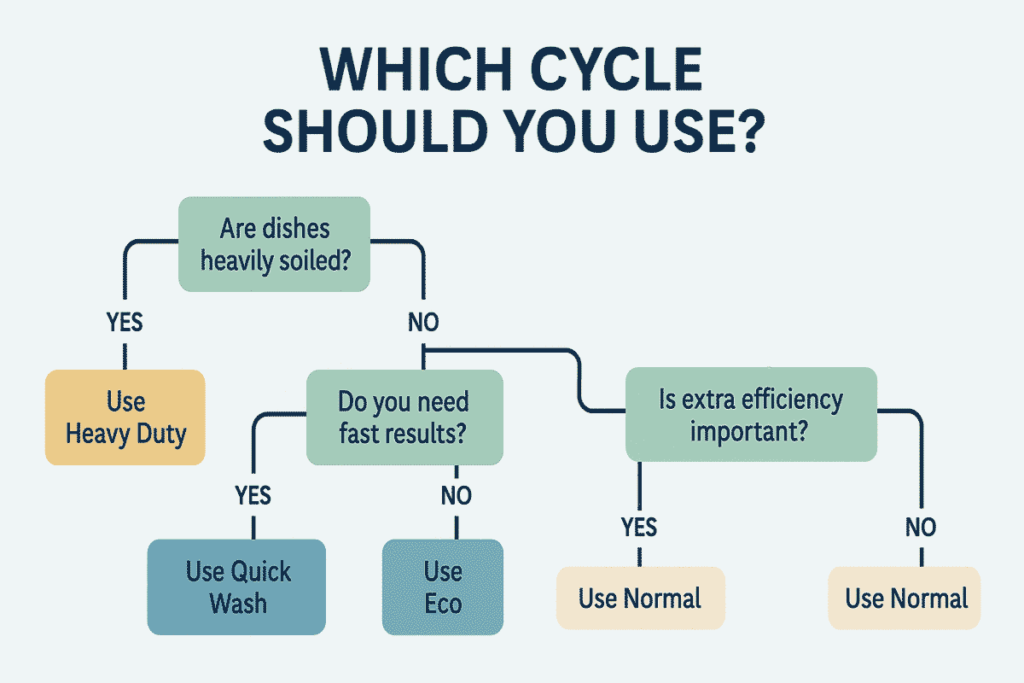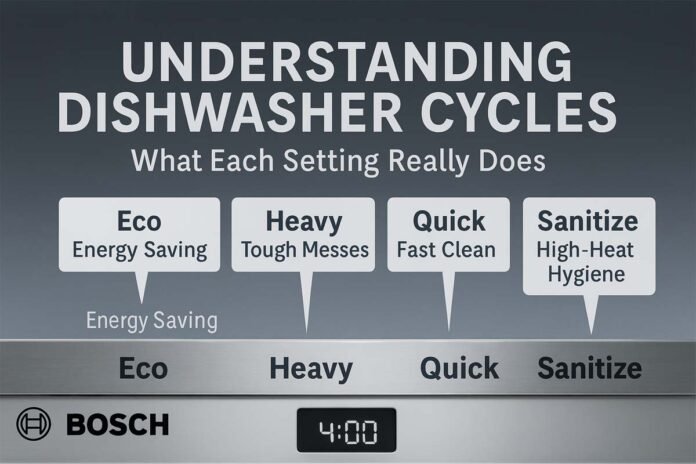Understanding dishwasher cycles can seem confusing, but choosing the right one can make a big difference in how clean your dishes get—and how much energy you use. If you’ve ever stood in front of your dishwasher wondering whether to press Normal, Eco, Heavy, or Quick Wash, you’re not alone. While today’s dishwashers are packed with smart technology and multiple cycles, many U.S. households only use one or two settings—often the wrong ones for the job.
Understanding what each dishwasher cycle does and when to use it can:
- Improves cleaning performance
- Extends the life of your appliance
- Reduce water and energy bills
- Protect delicate or expensive dishware
In our guide, we break down the most common dishwasher cycles found in modern machines, explain their purpose, and help you choose the right setting for your needs. Whether you’re looking to sanitize baby bottles, save energy on a light load, or blast through baked-on lasagna, there’s a cycle designed for that.
Let’s take a closer look at what each setting really does.
Overview of Common Dishwasher Cycles
Dishwashers typically come with a range of preset programs that vary in wash time, water temperature, pressure, and drying performance. Here are the most common dishwasher cycles you’ll find on U.S. models, from brands like Bosch, Whirlpool, GE, and KitchenAid.
Normal Cycle
The Normal cycle is the default setting on most dishwashers, and for good reason—it balances time, temperature, and energy usage to handle the average daily load.
What It Does:
- Uses moderate water temperature (120–140°F)
- Runs for 2 to 3 hours on most modern machines
- Designed for dishes with everyday food residue (not heavily baked-on or greasy)
Best For:
- Mixed loads of plates, cups, bowls, and utensils
- Families with 2–5 people using the dishwasher daily
- Users who scrape, but don’t pre-rinse
Pros:
- Efficient for standard use
- Often works well with automatic detergent pods
- Compatible with drying features like heated dry or fan assist
Cons:
- Not powerful enough for baked-on messes or pans
- May not sanitize without an added high-temp or sanitize option
Quick Tip: If you’re unsure which cycle to choose, Normal is usually a safe and efficient choice for most loads—especially when paired with a rinse aid for optimal drying.
Eco Cycle (Energy-Saving)
If you’re looking to reduce your utility bills or minimize environmental impact, the Eco or Energy Saver cycle is your best friend.
What It Does:
- Uses less water (as low as 3–4 gallons per cycle)
- Operates at lower temperatures (~110–120°F)
- Extends wash time (up to 4 hours) to compensate for gentler operation
Best For:
- Lightly soiled dishes
- Households in drought-affected or water-conscious areas (e.g. California, Arizona)
- Energy-conscious users trying to qualify for ENERGY STAR rebates
Pros:
- Saves both water and electricity
- Gentler on delicate dishware and glass
- Often quieter than heavier wash cycles
Cons:
- Not ideal for greasy or heavily soiled pans
- Can leave stuck-on food if dishes aren’t scraped properly
- Longer cycle may be inconvenient if you’re in a hurry
Did You Know? Many dishwashers use smart sensors to enhance Eco cycles. If your model has a “Sensor” or “Smart Wash” function, it may automatically adjust Eco settings based on the load size and soil level.
Eco vs Normal – When to Use Which:
- Use Eco when you’re running half-full loads, lightly used dishes, or you’re not in a rush.
- Use Normal for full daily loads with average messes.
👉 Related: [How Energy-Efficient Are Dishwashers in 2025?]
Heavy Duty / Pots & Pans Cycle
This is the go-to cycle for the dirtiest, greasiest, and most stubborn messes. Whether it’s casserole dishes with baked-on cheese or sauce-covered pots, the Heavy Duty (sometimes called Pots & Pans) setting is built for deep cleaning.
What It Does:
- Uses high water temperature (140–160°F)
- Extended wash and rinse time (often 2.5 to 4 hours)
- Stronger water jets and longer soaking periods
- May use more water (up to 10 gallons on some models)
Best For:
- Cookware with baked-on food, grease, or dried residue
- Large family meals, holiday cooking, or meal prep cleanup
- Dishes that haven’t been rinsed or soaked before loading
Pros:
- Powerful cleaning performance
- Reduces the need for scrubbing or soaking in the sink
- Some models boost drying for heavy ceramic or metal items
Cons:
- High energy and water usage
- Not suitable for delicate glassware or plastics
- Longer run times may delay next loads
💡 Pro Tip: Run this cycle overnight or during off-peak electricity hours to reduce utility costs. Consider using a detergent pod specifically designed for grease-fighting when selecting this setting.
Quick / Express Wash
When time is short and the dishes are only lightly soiled, the Quick Wash or Express Cycle can save the day. While it won’t handle sticky or baked-on food, it’s ideal for smaller loads or fresh-used dishes.
What It Does:
- Shortest cycle—usually 30 to 60 minutes
- Uses higher pressure but shorter rinse/dry times
- Best used with light loads or pre-rinsed dishes
Best For:
- Breakfast dishes or small loads after snacks
- Cleaning items shortly after use
- Hosting events with fast turnover of glassware or cutlery
Pros:
- Fast and convenient
- Uses less water overall
- Ideal for 1–2 person households or apartments
Cons:
- Limited cleaning power
- Often no heated drying
- Not suited for greasy or heavily soiled cookware
Quick Tip: If your dishwasher allows it, pair Quick Wash with a “heated dry” option for better drying performance.
Sanitize Cycle
The Sanitize cycle is an optional high-heat rinse that kills 99.9% of bacteria. It’s particularly useful for households with infants, immune-compromised members, or during cold and flu season.
What It Does:
- Raises final rinse temperature to 150°F+
- Certified by NSF on many U.S. models
- Sometimes combined with other cycles (e.g., Normal + Sanitize)
Best For:
- Baby bottles, cutting boards, and utensils
- Sanitizing pet bowls or water bottles
- Post-illness household cleaning
Pros:
- Peace of mind — especially for hygiene-sensitive users
- Often included in ENERGY STAR-certified dishwashers
- Helps improve drying results
Cons:
- Increases energy usage
- Can cause warping or fading of plastic items
- May extend cycle by 15–30 minutes
🔗 Helpful Link: [Is a Dishwasher Worth It? Pros and Cons for U.S. Households]
Auto / Sensor Wash
Modern dishwashers often feature Auto, Smart Wash, or Sensor Wash cycles that use turbidity sensors to assess how dirty the water is and adjust the cycle accordingly. Think of this as a self-driving mode for your dishwasher.
What It Does:
- Automatically adjusts water temperature, cycle time, and spray intensity
- Uses sensors to detect soil levels and load size
- Can switch mid-cycle to adapt to changing needs
Best For:
- Mixed loads where soil levels vary
- Households that don’t want to guess the right cycle
- Busy users who value convenience
Pros:
- Optimized cleaning with minimal input
- More efficient use of water and energy
- Often includes pre-rinse or soak phase automatically
Cons:
- Less predictable cycle time (ranges from 90 to 180 minutes)
- Slightly more expensive feature — found in mid-to-high-end models
Did You Know? Some models use “Auto + Eco” combinations to deliver the best balance of performance and efficiency based on real-time data.
Rinse Only / Pre-Rinse
The Rinse Only or Pre-Rinse cycle doesn’t clean dishes—it simply sprays them with water to prevent dried-on food until a full load is ready. It uses no detergent and minimal water.
What It Does:
- Brief cold or lukewarm water spray (typically 10–15 minutes)
- No soap or drying
- Helps keep dishwasher odor-free between washes
Best For:
- Households that don’t run a full load daily
- Holding dishes overnight or over the weekend
- Preventing buildup in shared homes or offices
Pros:
- Saves you from pre-rinsing at the sink
- Reduces food crusting on plates
- Extremely low water usage (1–2 gallons)
Cons:
- Not a cleaning cycle—doesn’t remove grease or grime
- Not available on all models
Quick Tip: If you’re using this setting, don’t forget to run a full cycle within 24–48 hours to prevent odors.
🔗 Related Read: [Checklist for Buying a Dishwasher: The Ultimate Guide for Smart Shoppers]
Choosing the Right Cycle for the Job
With so many dishwasher cycles available, choosing the right one for your specific needs can make a big difference in cleaning performance, energy use, and time management. Here’s a practical guide to matching cycles with real-life situations:
Everyday Family Use → Normal or Auto
For most average-size U.S. households (2–5 people) running one full load per day, the Normal cycle is the most reliable. It balances cleaning power and efficiency. If your model has a Sensor/Auto Wash, that’s an even better option—it adjusts automatically.
Example:
You cook dinner, rinse the plates lightly, and load everything—go with Normal.
Not sure which dishwasher cycle is right for your load? Use this simple visual guide to decide between Normal, Eco, Heavy, Quick, and other settings based on time, soil level, and dish type.

Energy-Conscious Households → Eco
Trying to lower your utility bill or reduce your water footprint? Choose the Eco cycle—especially in areas with high electricity rates like California or New York.
Use it when:
- The load is only lightly soiled
- You’re not in a rush
- You’re running the dishwasher overnight
🔗 Related: [How Energy-Efficient Are Dishwashers in 2025?]
After a Big Meal or Holiday Cooking → Heavy Duty / Pots & Pans
For loads with stubborn messes—think lasagna, baked mac and cheese, or greasy pans—the Heavy cycle ensures thorough cleaning.
Pro tip: Use this after hosting dinner or batch cooking for the week.
Fast Turnaround → Quick Wash
Need clean dishes quickly? If they’re not too dirty, Quick Wash can save the day. Ideal for:
- Breakfast dishes before work
- Cleaning plates for a second dinner round
- Small households or apartments
Hygiene Priorities → Sanitize
If you have babies, pets, or a household member recovering from illness, a Sanitize cycle is worth using regularly. It’s especially valuable during cold and flu season.
Use on:
- Baby bottles, cutting boards, sippy cups
- Water bottles, food storage containers
Loading Dishes Over Several Days → Rinse Only
If you only run full loads every 2–3 days, Rinse Only keeps odors and food crust away.
🔗 Related: [What Not to Put in a Dishwasher – 2025 Guide]
Quick Overview Table:
| Situation | Recommended Cycle | Notes |
|---|---|---|
| Daily mixed load | Normal or Auto | Great for families of 2–5 |
| Lightly soiled, energy saving | Eco | May run longer but saves on water/electricity |
| Greasy pots and pans | Heavy Duty | High heat and power, best for stubborn food |
| Fast cleaning needed | Quick/Express Wash | For small, lightly soiled loads |
| Hygiene or illness concern | Sanitize | Kills 99.9% of bacteria with high-heat rinse |
| Holding dishes for full load | Rinse Only | Keeps smells away, no detergent needed |
Why Understanding Dishwasher Cycles Matters for Energy Use
One of the most confusing parts about dishwasher settings is how long each cycle takes and how much energy or water it uses. Surprisingly, shorter doesn’t always mean more efficient, and longer doesn’t always mean wasteful.
General Duration & Water Use by Cycle:
| Cycle | Average Time | Water Use (Gallons) | Energy Use |
|---|---|---|---|
| Quick Wash | 30–60 minutes | 2–4 gallons | Low |
| Normal | 2–3 hours | 4–6 gallons | Moderate |
| Eco | 2.5–4 hours | 3–5 gallons | Very Low |
| Heavy Duty | 2.5–4+ hours | 6–10 gallons | High |
| Auto/Sensor | 1.5–3 hours | Varies (3–7 gal) | Adaptive |
| Rinse Only | 10–15 minutes | 1–2 gallons | Minimal |
| Sanitize (add-on) | +15–30 minutes | Adds 0.5–1 gallon | Boosts energy usage |
Important Notes:
- Newer ENERGY STAR models use less water but take longer because they rely on soaking rather than high water volume.
- Heated drying and sanitize options add to energy use.
- Hard water can affect efficiency — using dishwasher salt helps performance (🔗 [The Right Salt for My Dishwasher]).
Efficiency Tip:
If your utility company offers time-of-use pricing, consider running your dishwasher with a delayed start during off-peak hours to save money—especially for longer cycles like Eco or Heavy.
For more data on water usage, check the ENERGY STAR Dishwasher Specs.
Pro Tips for Better Results
Even the best dishwasher cycle won’t deliver spotless dishes if the machine isn’t loaded or maintained properly. These practical tips can help boost performance, save energy, and extend the life of your appliance.
🧼 1. Don’t Pre-Rinse — Just Scrape
Modern dishwashers are designed to detect food particles and adjust washing accordingly. Pre-rinsing may actually confuse the sensor and waste water.
✅ Do: Scrape off large food pieces.
🚫 Don’t: Fully rinse with water unless dishes sit for over 24 hours.
📐 2. Load Dishes the Right Way
Proper loading is key to water and detergent reaching all surfaces.
- Plates: face inward on bottom rack
- Bowls/cups: angle downward on top rack
- Utensils: mix forks, spoons, knives to avoid nesting
🔗 Related: [Checklist for Choosing a Dishwasher] – includes a diagram of correct loading
🧴 3. Use Rinse Aid and Salt (If Needed)
- Rinse Aid boosts drying and prevents water spots—especially useful for glassware and plastics.
- Dishwasher Salt helps prevent limescale buildup in hard water areas, improving efficiency and performance.
🔗 Related:
- [The Right Rinse Aid for My Dishwasher]
- [The Right Salt for My Dishwasher]
🔁 4. Clean the Filter Monthly
Your dishwasher has a small filter under the bottom spray arm. A dirty filter can lead to odors, poor drainage, or greasy dishes.
➡️ Remove, rinse, and reinsert it once a month.
🔗 [How to Clean My Dishwasher] — step-by-step maintenance guide
🔌 5. Use Delay Start for Off-Peak Savings
Most dishwashers now offer a Delay Start feature, allowing you to run cycles overnight or during off-peak energy hours.
✅ Smart usage = Lower energy bills.
Frequently Asked Questions (FAQ)
❓ What’s the most energy-efficient dishwasher cycle?
The Eco cycle is usually the most energy-efficient. It uses lower temperatures and less water over a longer period, making it ideal for lightly soiled dishes.
❓ Can I use the Heavy cycle for all my dishes?
While the Heavy cycle gives great cleaning results, it’s not designed for everyday use. It uses more water and heat, which could damage delicate items and raise your utility bill. Stick to Normal or Auto for daily loads.
❓ Should I always use the Sanitize setting?
Only use Sanitize when necessary—like for baby items, cutting boards, or illness recovery. It raises the rinse temp to 150°F+, which can increase energy use and degrade plastics over time.
❓ Why does the Eco cycle take so long?
The Eco cycle cleans dishes using lower temps and less water, so it extends the duration to maintain effectiveness. It’s slower but much more energy-efficient than a quick or heavy cycle.
❓ Is Quick Wash good enough for most meals?
Only if dishes are lightly soiled. Quick cycles skip intense soaking and typically don’t use heated drying, so results may vary. For heavier loads, Normal or Auto is safer.
Conclusion: Get the Most from Every Wash
Understanding dishwasher cycles isn’t just about pushing the right button—it’s about saving time, water, and energy while keeping your dishes sparkling clean. Whether you’re running a fast rinse before guests arrive or deep-cleaning holiday cookware, there’s a cycle that fits your needs.
✅ Summary Takeaways:
- Use Normal or Auto for most everyday needs
- Choose Eco to reduce bills and conserve water
- Go with Heavy for messes, and Sanitize when health matters
- Don’t forget Rinse Only for in-between loads
📌 Looking to upgrade your dishwasher?
Check out our expert picks in these helpful guides:
- 🔗 [Best Dishwashers for 2025 | Buying Guide]
- 🔗 [Best Dishwashers Under $500 in 2025: Affordable, Reliable & Efficient Picks]
- 🔗 [Best Dishwasher Brands Compared: Bosch vs Whirlpool vs GE in 2025]
- 🔗 [The Ultimate Dishwasher Buying Guide: How to Choose the Perfect Appliance]





